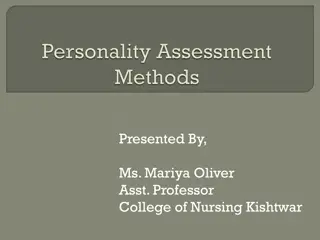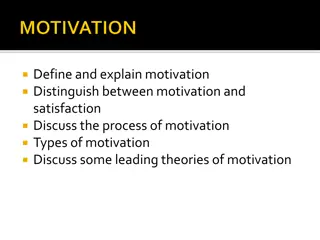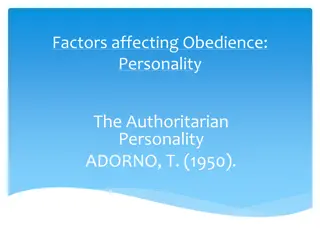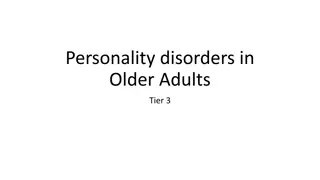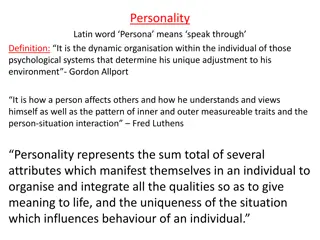Understanding Achievement Motivation and Competitiveness in Personality
This content explores the interconnection between personality traits and the level of competitiveness individuals exhibit, focusing on achievement motivation theories such as Murray (1938), Bandura (1997), Atkinson & McClelland (1976), and NACH and NAF. It delves into the factors influencing achievement motivation, such as the probability of success and incentive value, as well as how individuals with high and low needs for achievement and fear of failure differ in their approach to success and failure. The critical evaluation section highlights different perspectives on interpreting achievement and success, emphasizing ego-goal orientation versus task orientation.
Uploaded on Oct 07, 2024 | 0 Views
Download Presentation

Please find below an Image/Link to download the presentation.
The content on the website is provided AS IS for your information and personal use only. It may not be sold, licensed, or shared on other websites without obtaining consent from the author. Download presentation by click this link. If you encounter any issues during the download, it is possible that the publisher has removed the file from their server.
E N D
Presentation Transcript
ACHIEVEMENT MOTIVATION Links personality with the degree of competitiveness shown by an individual
THEORIES Murray (1938) ; Natural for one individual to strive to surpass another. Bandura (1997) ; Competitive drive is a product of learning Seen this spectrum before? What s the third?
ATKINSON &MCCLELLAND (1976) Achievement motivation is a personality trait which is activated by a situation. The situation comprises two things: 1. Probability of success the extent to which success is likely; success is more likely if the task is found to be easy 2. Incentive value of success the intrinsic value experienced by the individual after success has been achieved; the harder the task, the greater the incentive value as probability of success is reduced
NACH AND NAF High need to achieve (High Nach) Low need to achieve (Low Nach) Also associated with the low need to avoid failure (low Naf). The desire to succeed far outweighs the fear of failure. Also associated with a high need to avoid failure (high Naf). The fear of failure far outweighs the desire for success. These performers are high in achievement motivation and referred to as high achievers These performers are low in achievement motivation and referred to as low achievers
EXPLAINED This model best predicts behaviour responses in situations with a 50/50 chance of success: This will trigger approach behaviour and mastery orientation with a high incentive value in an evenly balanced chance of success OR Triggers greatest anxiety in 50/50 chance of success, leading to avoidance behaviour and learned helplessness Approach or avoidance behaviour are most likely to occur in an evaluative situation a situation in which the performer believes they are being assessed
CRITICAL EVALUATION Achievement or success can be interpreted in many ways Some performers regard success as victory over other people (Long Jump). These people have ego goal orientation . They believe that ability and comparison against others are the criteria for success Others judge on personal improvement task orientation . These people value internal goals and believe that effort and comparison with self are the criteria for success Achievement motivation is a general term, used to cover achievement in all areas .
SPORT SPECIFIC ACHIEVEMENT MOTIVATION (COMPETITIVENESS) The motivation to achieve in sport. Gill and Deeter (1988) used their own Sport Orientation Questionnaire (SOQ) and confirmed that athletes were far more competitive than non-athletes. Significantly ; Athletes favoured performance goals (task orientation) while non- athletes emphasised the importance of winning (ego orientation) The type of goal set by teacher/coach as the measure of success in sport related activity has a huge bearing upon a decision to adopt and sustain a BAHL.


